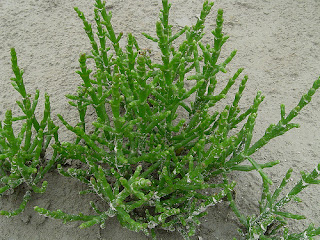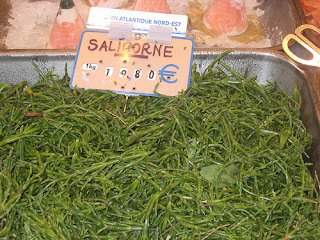from
Behind the French Menu
by
Bryan G. Newman
behindthefrenchmenu@gmail.com
Samphire growing in the sandy soil.
www.flickr.com/photos/47689195@N00/293924476/
Samphire (salicornia) is not a seaweed:
Samphire is often, mistakenly, called an edible seaweed; it is not. It is a coastal plant, with many family members, and grows in salt marshes and even in the sand along the coast. Its shape, not its taste, gives it another name, sea asparagus.
The mildly salty and slightly bitter taste of Samphire along with its crunchy texture (when properly cooked) allows it to partner well in many salads when served cold or when served warm with fish or shellfish.
British phaenogamous botany 1834-1843
www.flickr.com/photos/biodivlibrary/28992508086/
Salicornia on French menus:
Mesclun - Queues d'Écrevisses - Salicornes - A mixed green salad with freshwater crayfish tails and samphire. N.B. A salade mesclun should, by tradition, include at least five different salad greens.
Samphire salad with a thinly cut, cold, tri-tip steak.
The tri-tip cut is the aiguillette baronne in France.
www.flickr.com/photos/tavallai/4833766606/
Filet de Sandre aux Salicornes, Beurre Blanc – A filet of zander, (pike-perch), with samphire served with a white butter sauce.
Crisply fried European seabass with samphire.
Flétan Meunière aux Salicornes – Halibut prepared in a meunier sauce accompanied by samphire, Meunier is a sauce of butter, lemon juice and parsley served warm.
Conchiglie Farcies aux Gambas et Salicornes - Shell shaped pasta stuffed with large shrimps and samphire.
Samphire in a Parisian market.
www.flickr.com/photos/mlazarow/1378640343/
As samphire reaches a wider public, more recipes are being created for using these vegetables in salads, sauces, soups as well as for pickling them for use out of season as a condiment. Some French market gardeners have felt the demand and are now cultivating the plant, but along France’s Atlantic coast young, wild samphire plants are still gathered in the wild from April through July. Many of these gatherers, ramasseurs in French, are professionals and under contract to restaurants. Throughout the year these same gatherers will be working further inland collecting wild herbs, fruits, and vegetables such as wild leeks, wild garlic, and wild berries including juniper berries and elderberries along with wild mushrooms like cepes, and chanterelles.
Samphire flowering on the coast.
In the department of Charentes Maritime.
Connected Posts:
Searching for the meaning of words, names or phrases
on
French menus?
Just add the word, words, or phrase that you are searching for to the words "Behind the French Menu" and search with Google. Behind the French Menu’s links include hundreds of words, names, and phrases that are seen on French menus. There are over 450 articles that include over 4,000 French dishes with English translations and explanations.
Behind the French Menu
by
Bryan G. Newman
behindthefrenchmenu@gmail.com
Copyright 2010, 2016, 2018.







No comments:
Post a Comment